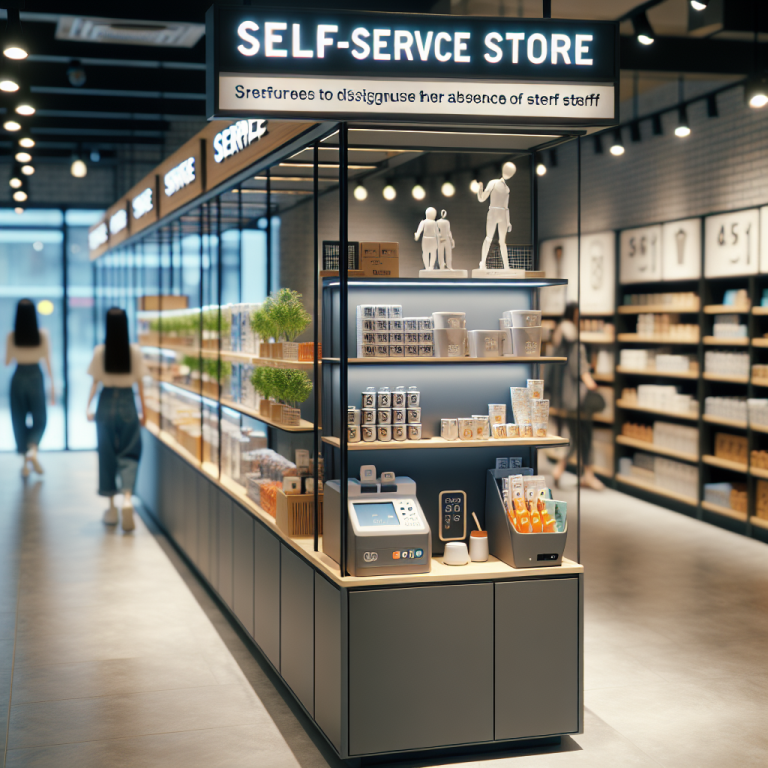Employee-Free Store: A Breakthrough in Modern Retail
Employee-free stores are gradually establishing their position in modern retail, creating a significant breakthrough in how consumers approach and experience shopping. With the advancement of technology, this model not only helps reduce operating costs but also quickly meets the increasing demands of customers.
What is an Employee-Free Store? Definition and Characteristics
An employee-free store is a form of retail where customers self-serve and pay without the need for direct interaction with staff. This model is often accompanied by technologies such as facial recognition systems, IoT sensors, and automatic payment applications, optimizing the shopping process. The outstanding feature of this model is the convenience and speed it offers to consumers.
The Development History of Self-Service Stores: From Concept to Reality
Self-service stores are not a completely new concept. Their development history can be traced back to the first self-service stores that appeared in the 1940s in the United States. However, with technological advancements, this model has been modernized and developed more strongly in recent years, especially after the COVID-19 pandemic. Consumers increasingly prefer contactless shopping, which has led to the emergence of many employee-free stores worldwide.
Differentiating Employee-Free Stores from Traditional Retail Models
Employee-free stores differ from traditional retail models by emphasizing self-service and technology application. While traditional stores have staff serving at counters and handling transactions, employee-free stores allow customers to freely choose and pay without encountering any obstacles. This not only reduces waiting times but also creates a more enjoyable shopping experience.
Why Have Employee-Free Stores Become a Trend? Driving Factors
The driving factors behind the development of employee-free stores include changes in consumer behavior, the demand for convenience, and efficiency. Customers are increasingly seeking easy and quick shopping experiences, which has significantly impacted traditional retail models.
Technology Application: The Key to Unlocking the Age of Automated Stores
Technology plays a crucial role in forming and developing the employee-free store model. Technologies like AI for user data management and analysis, IoT for inventory tracking, and automated payment systems have helped stores operate more efficiently and intelligently.
Changing Consumer Behavior: Preference for Convenience and Speed
For modern consumers, convenience and speed are the top priorities when choosing a shopping place. Employee-free stores fully meet this demand by allowing customers to enter and shop quickly without waiting or encountering many obstacles during payment.
Outstanding Advantages of Employee-Free Stores: Cost Savings, Operational Optimization
This model brings numerous benefits to businesses, including reduced personnel costs, optimized operational processes, and improved business efficiency. Employee-free stores have the ability to operate 24/7 without difficulties, thus resulting in higher profits for businesses.
Increasing Revenue and Improving Customer Experience with Self-Service Stores
Employee-free stores offering customers flexibility and decision-making power in their shopping journey will lead to revenue growth for businesses. Customers will return if they are satisfied with the experience they receive.
Challenges in Implementing Employee-Free Stores: Security, Technology, and Management
However, this model is not without its challenges. Issues related to security, management, and technology can pose difficulties for businesses in the implementation of employee-free stores. Ensuring the safety of goods and preventing fraudulent behaviors is always a top priority.
Overcoming Barriers: Solutions for Common Issues in Automated Stores
To address these challenges, businesses need to invest in security technologies, train staff so they can effectively manage the system, and continuously improve the customer experience.
Technologies Fundamental to Employee-Free Stores: AI, IoT, and Automated Payments
Technologies like AI, IoT, and automated payment systems are key factors in ensuring the efficient operation of employee-free stores. AI helps analyze customer data, thereby optimizing the shopping experience. IoT provides real-time inventory tracking capabilities, while automated payment systems enhance transaction processing speed.
AI Cameras and Facial Recognition Systems: Enhancing Security and Management
AI camera systems and facial recognition technology are becoming increasingly popular in employee-free stores, not only enhancing security but also aiding in the analysis of consumer behavior. This means businesses can create marketing strategies that better align with customer needs.
Contactless Payments and Mobile Applications: Optimizing the Shopping Experience
Contactless payments and mobile applications have become trends in employee-free stores. Customers can easily pay by scanning barcodes or using applications on their smartphones, thereby optimizing the shopping experience to the fullest.
Employee-Free Stores Worldwide: Successful Models and Lessons Learned
Globally, many employee-free store models have emerged and achieved remarkable success. Notable models like Amazon Go have not only changed the traditional definition of stores but have also opened new opportunities for other businesses…
Employee-Free Stores in Vietnam: Development Potential and Investment Opportunities
In the context of Vietnam, employee-free store models are beginning to be implemented. The rapid development of information technology alongside changing consumer behavior in Vietnam has created opportunities for this model to develop strongly in the future.
Trends in the Development of Self-Service Stores: Personalization, Sustainability, and Connection
In the future, employee-free stores will continue to develop towards personalizing the shopping experience, focusing on sustainability and the connection between brands and customers, thereby increasing value for both parties.
The Future of Retail: The Rise of Employee-Free Stores
We are witnessing a strong rise of the employee-free store model. In the near future, this will become an indispensable part of retail, opening up new opportunities for investment and business development.
Case Studies: Analyzing the Most Successful Employee-Free Stores
To gain a deeper understanding of how this model operates and develops, we can study some exemplary success cases. Stores like Amazon Go, Zippin, or AiFi provide us with valuable lessons about technology application and how to build a great customer experience.
Lessons from the ‘Giants’: Secrets to Success in Operating Automated Stores
Large enterprises have shown that to succeed in operating automated stores, they need many factors such as a clear technology orientation, adaptability to market needs, and building a staff capable of managing complex technology systems.
Employee-Free Stores: The Retail Revolution Has Begun
Employee-free stores are marking a revolution in the retail industry. To survive and thrive, businesses need to be prepared for this trend, from investing in technology to reaching customers in a more flexible and effective manner.
Preparing for the Future: Investing in Automated Stores to Lead the Trend
To stay ahead of the employee-free store trend, businesses need to proactively invest in technology, from improving customer experience to enhancing competitive capabilities in the market. Thorough preparation for the future will help them stand out in the retail sector and attract more customers.
Contact us today for tailored consultation!
Intage Vietnam: Your trusted partner for comprehensive and effective market research solutions.
📞 (+8428) 3820 5558
🌐 https://intage.com.vn/
🏢 45 Vo Thi Sau, Da Kao Ward, District 1, Ho Chi Minh City, Vietnam





